How The Internet’s Bad Pennies (Eventually) Turn Into Gold
As an almost official old man of the modern Internet—I founded a web development firm in 1994—I keep seeing ideas I thought were dead and buried break the surface of the digital ocean, fly free for a moment, and then sink back to the bottom.
But cynicism is a lazy habit. Despite criticism from pundits such as myself—and the unseen hand of the marketplace slapping down repeated iterations of some seemingly lousy notions—the web’s bad ideas ultimately transmute into mostly good ones. Sometimes billions of dollars and many years are wasted in getting to that point, but that may mean that these “bad” ideas are good in the end. In their original form, they just arrived before the technology was mature or the market was ready.
The evolution of bad ideas into successful businesses brings to mind research firm Gartner’s Hype Cycle: after a “peak of inflated expectations” and the “trough of disillusionment,” an upward slope brings enlightenment and utility. With these bad ideas, the peak/trough cycle has repeated multiple times before the idea drags itself out of the ditch.
Home Grocery Delivery: From WebVan To Instacart
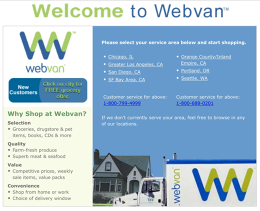
Then: During the original dot-com boom, HomeGrocer, Webvan, Peapod, and others said we could live in the future, ordering groceries online, which would be delivered to our homes in as little as a couple of hours, ditching the terrible inconvenience of leaving our premises, choosing goods, and interacting with other people. The horror.
These grocery shopping and delivery services were a reboot of the kind of delivery options that local markets offered years ago, with the digital twist of letting you select products and pay for them online. The biggest ones started with the assumption that they would effectively become warehouses from which items would be picked and driven to consumers’ homes.
That proved to be incorrect, at least in timing. When the dot-com crash hit in 2001, the capital needed to keep those operations running disappeared, and Webvan (which had purchased Homegrocer) went under. Peapod, which was founded prior to the rise of the Internet, survived the hecatomb by selling itself in 2000 to global grocery firm Ahold, which operated the Stop & Shop and Giant Food chains in the U.S.
It’s with some trepidation that I reveal in researching this article, I found that in 1955, my family’s furniture business in Poughkeepsie, New York, offered a flat-rate, family-oriented grocery delivery service, bundled with a “free” freezer. My father, asked to comment, said he couldn’t recall such a service, and suggested it was run by General Electric with local branding; our stores sold GE appliances.
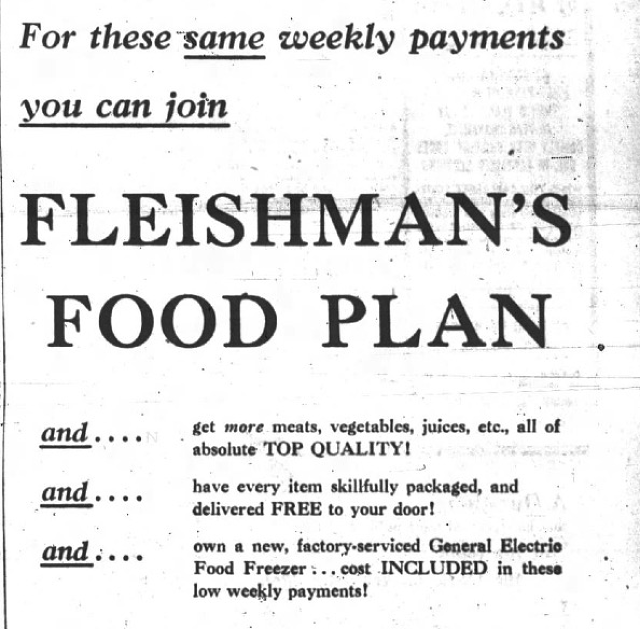
Now: The online grocery business never died, it only shifted. Grocery chains other than those owned by Ahold, such as Safeway, started getting into the act before Webvan’s demise, and accelerated when they had a less crowded field. Many of those approaches rely on using the inventory in existing stores, allowing pickers to pull from the shelves or from backroom stock, and deliver within a small radius. That’s a less ambitious approach to the idea than building warehouses from scratch, but also perhaps a more practical one.
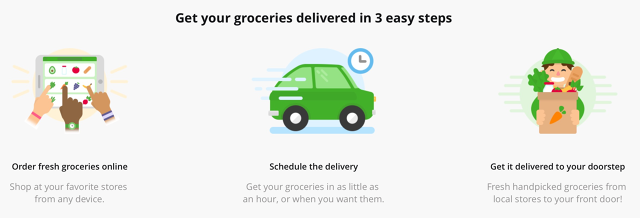
Instacart, founded in 2012, built on the in-store picker idea, and sent its employees into groceries with which they didn’t have a relationship to buy groceries, and then charged a sizable markup. That caused some friction, and the company eventually built direct partnerships with many grocers, replacing existing programs in some cases, while also lowering the cost to consumers. Whole Foods invested directly in Instacart in 2016. Postmates, founded a year prior to Instacart, delivers from some grocers as well as other merchants.
Amazon dipped its toes in the water starting in 2007 with AmazonFresh, which relied on the Webvan-like central warehouse model, but only in its hometown of Seattle. It took until 2013 before it added cities beyond the Seattle metro area. In 2015, it shifted to a very odd model, requiring a “super” Prime account that costs $299 a year (as opposed to the standard $99 version of Prime) and includes free delivery on orders of $50 or more.
At the same time, it launched Amazon Prime Now, a same-day delivery service that requires a regular Amazon Prime membership, operates in many U.S. cities, and works with restaurants and Amazon’s own inventory—and competes with Instacart by partnering with stores. In Seattle, Amazon Prime Now and Instacart both serve as a home-delivery option for a local large grocery co-operative chain, PCC Natural Markets.
Silver linings: Rather than spell the end of neighborhood groceries or mega-supermarkets, online ordering and home delivery has seemed to melt into the fabric of customer expectations for fresh, frozen, and packaged food. Lessons learned in each wave seemed to make the next one more efficient.
Robotics developed at WebVan fed into a company founded by an ex-WebVan executive, which was later purchased by Amazon to use with AmazonFresh. And WebVan’s founder, Louis Borders, who also founded the eponymous and now defunct bookstore chain, has a startup aimed at major retailers who don’t want to build their own home-delivery operations.
Tip Jars: From TipJoy To Patreon
Then: Cast off your wage shackles, writers, cartoonists, and other creative folk! In the era when it first became easy to bypass big media companies and launch your own website, monetizing content was a challenge. Some said that the future of payment was jangling a can full of coins on your “Web log” and hoping people dropped in pennies and sometimes a few bills.
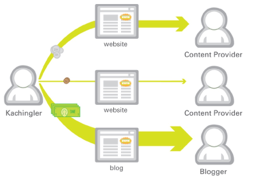
The notion was that the ever-increasing flood of millions of people joining the Internet would let you turn a tiny fraction of a mass audience into a sideline or even a living. But there was a problem. How would you collect money from random people over the net?
Starting in the 1990s, a host of solutions rose and mostly fell, some of which were also part of the micro-payment movement (see below): Flattr, TipJoy, Twitpay, Amazon Honor System, CyberCash, YouTube Fan Funding, Kachingle, and many more.
Tip jars never amounted to much to most people and sites, even those with high traffic, because the friction of offering a way to pay typically on a one-time basis often with a new payment system was so high, most people didn’t bother. As with all things related to attention, the power-law curve allows for some large successes, but most people earned a pittance, often not enough to redeem as a check or direct deposit.
Now: A few systems persist, like Flattr, and new ones keep getting invented, though more often integrated with hosting platforms or sites, so that readers or other members can send real money or virtual money. (Flattr appears to be pivoting toward an ad-block system, too.) While Venmo and Square Cash weren’t designed for paying site proprietors, they can fit the bill for direct, low- or no-cost one-time cash transfers.

Theoretically, Bitcoin is a perfect tip jar method, as it has no registration, extremely small transaction fees, and allows very small value transfers. However, its adoption outside of specific fields of interest, like anarchy, remain too low to rely on it as even a slight source of income for most people.
Silver linings: Many creators of the type who hoped tip jars would fill up had some success with crowdfunding, which began as a substantial category in 2010. Patreon, founded in 2013, has become the recurring contribution site of choice for cartoonists, bloggers, musicians, podcasters, and others to receive donations of as little as $1 a month.
Micropayments: From QPass To Bitcoin
Then: You remember Richard Pryor’s odd turn as a criminal computer genius in Superman III? He figured out a way to siphon off fractions of a cent left behind in banking transactions. (Yes, the notion was recycled and cited in Office Space.) Micropayments relied on similar thinking.
Most online transactions still involve a credit card, and except for the largest merchants, most online collection costs about 2.9% of the total, plus 30 cents—which means that charging someone a buck costs you 33 cents. The costs were even higher in the 1990s if you managed to leap through hurdles to accept credit cards online, and typically came with monthly fees to boot.
Micro-payments wanted to enable visitors to be charged or donate pennies, or even fractions of a cent, at a time, whether per page view, download, or other action. The trick was aggregation: Instead of charging each transaction separately, a micropayment outfit would monitor actions across a set of sites. Some charged when a threshold was hit; others had you pledge or commit a dollar amount each month which was distributed among participating sites. (That’s the overlap of tip jars and micro-payments right there.)
Many, many companies entered the field, especially catering to magazines and newspapers, which were struggling to find a way to balance the availability of online content with the concomitant loss of subscriptions, newsstand sales, and associated print-advertising revenue. Products and companies included Qpass, DigiCash, Cybercoin (from the aforementioned Cybercash), Kachingle (here, too), Millicent, Cha, and even PayPal.
The flaw came in interoperability. Even though many of these systems signed up sometimes dozens of major periodicals or editorial sites or thousands of smaller operations, there were still too many that didn’t naturally cover all of one person’s interest.
According to Nathaniel Borenstein, one of the founders of the firm that created CyberCash (and one of the creators of the MIME email attachment format) “the major players don’t care about micro-payments, because the transaction charges aren’t worthwhile. True micro-currencies are therefore doomed.”
Now: Micropayment has largely disappeared in favor of advertising, membership, subscriptions, sponsorships, and outright patronage. As with tip jars, Bitcoin could be an effective way to transfer tiny amounts at little cost, but there’s no widespread use of it by sites that would benefit the most.
Silver lining: Newer efforts around aggregated micro-currency payments, such as newsreader Blendle, seem determined to have substantial partners and worthwhile content at launch, rather than building the airplane after leaping off the cliff. Borenstein remains bullish on aggregation.
Push Technology: From PointCast To Smartphone Notifications
Then: A dam broke loose around 1996, when PointCast launched a simple desktop client that let the company send or “push” stock, news, sports, and other information on a schedule it set to a screensaver-style desktop client. Dozens of companies were founded, and PointCast became a not-quite unicorn of its day, with a purported $450 million offer on the table in 1997 from News Corporation.

But companies were too eager to push advertising alongside news and the data PointCast pushed clogged the era’s low-speed Internet connections. The service either overwhelmed corporate networks with constant updates to hundreds or thousands of internal users—or network administrators believed it did. For users at home, where dial-up still reigned, it was even worse.
By 1998, the industry was teetering; in 1999, it mostly imploded. Push never recovered, and became something of a cautionary tale. Even “push” email—in which a server sends new messages to a client instead of the client polling at intervals to fetch new ones—was sometimes given a gimlet eye because of network demands and battery-sucking potential on cell phones.
For a while, RSS replaced push. RSS is a pull technology, in that an RSS reader, browser, or online site regularly checks for the update of a feed and retrieves it when it’s refreshed. Google Reader absorbed much of the demand for RSS, and by the time it was shut down in 2013, Facebook and Twitter had picked up a fair degree of the slack.
Now: The scroll-through-items notifications lock screen pioneered first by Google Android and then adopted and modified by Apple is arguably the push of our day.
Silver lining: Who likes to be talked at? Push in its original pushy form deserved to fail.
Web Annotation: From Third Voice To Genius
Then: There’s something impossibly irresistible about developing technology that lets you write on top of other people’s work, whether or not those folks give you permission. One could argue that the Talmud, a conversation on Biblical passages conducted in the margins over hundreds of years, is a precursor to modern systems. If only recent entrants were nearly as erudite and polite!
Third Voice gets the nod as the first in its category. Requiring a browser plug in, someone with a Third Voice account could add notes and other details on top of any web page, and only those with the plug in could see them. The idea sparked an enormous amount of outrage from those who felt that the service hijacked their content. One newsgroup poster in 1999 summarized the view: “I have a serious problem with them being able to post it in such a way that it appears to be part of my site.” The concern was that if Third Voice became popular enough, a site could be effectively overwritten by unrelated parties. The company flamed out relatively quickly.
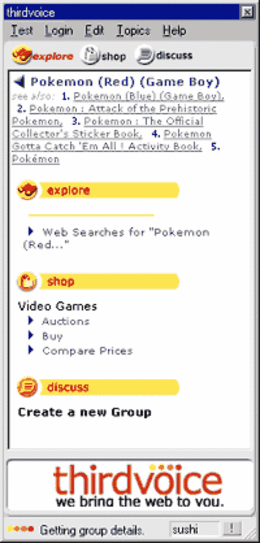
It was followed by a stream of others, many of which seemed to be created by people who hadn’t heard of the previous efforts. Spinspotter, SideWiki, QuickTopic (in its original incarnation), Microsoft Edge (not to be confused with Windows 10’s browser ), E-Quill (which let you email Web annotations), Diigo, and Annotea/Amaya, to name a few. Some of these had web annotation as an aspect of another product; some required plug ins or ecosystems; some had a single market in mind; some were proofs of concept. Only Diigo still both exists and remains in much its same format—but it’s structured around personal annotation and group sharing, rather than pushing out conversations to the web at large.
Now: Genius Web Annotator and Hypothesis are modern iterations of Third Voice, though they would almost certainly reject the comparison. Genius started by posting the full lyrics of rap songs that users could add notes to, then expanded into all music, and then into books and other media; more recently it’s extended to news. Hypothesis has had more of an academic and scientific bent from the start, though it covers news, politics, and other categories as well.
While both Genius and Hypothesis offer web plug ins to handle mark up and display, both services can bypass a plug in and display an overlay and editing tools at a unique URL run by the company. Both accomplish these using a proxy: When a request for a page comes in, the service requests the page as if the Web surfer were visiting directly, then rewrites the page code to inject JavaScript that displays annotations and enables editing.
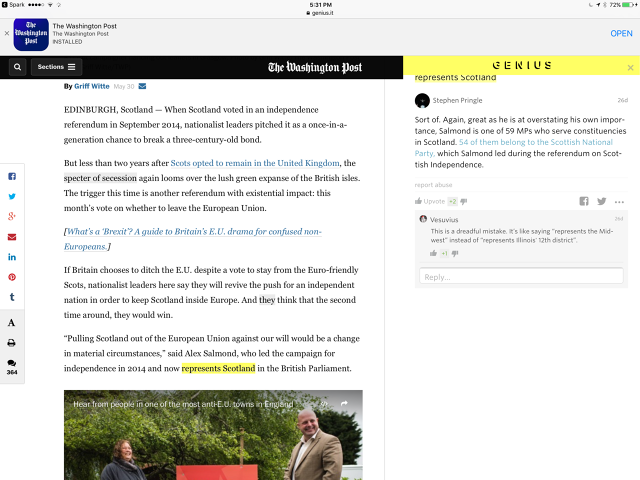
Neither company offers sites the ability to opt in nor opt out, which can be problematic. Annotation can be arguably vital (and overcome potential copyright issues via fair use) when criticism offers some social good, such as marking news stories with invented quotations, scientific papers that seize credit or fail rigor, or even company press releases that leave out inconvenient truths. That social good is hard to justify when applied to personal writing on a blog. After anti-stigma advocate Ella Dawson had a blog post about victimhood and herpes annotated at Genius, including by the News Genius editor, it sparked a wide-ranging debate that mirrored the one related to Third Voice years earlier, and swept in the interest of a congressperson, Katherine Clark (D-Mass); Genius responded to Rep. Clark’s letter. (Disclosure: Dawson is a friend of mine.)
Currently, the World Wide Web Consortium (W3C) is working on a standard for annotation that could result in major browsers having built-in support to display overlays without using a proxy trick. That means anyone’s musings on any Web page could be available easily to anyone in the world without even visiting a special URL.
Silver lining: In their best cases, Genius and Hypothesis have a similar high purpose of wanting to footnote items of social, political, academic, and scientific interest to add rich layers of additional meaning that reduce the ability of individuals or groups to control the narrative.
Bar And Tag Code Readers: From CueCat To QR Codes
Then: Imagine this: You attach a bar code scanner in the shape of a cat to your PC and install some software. Then, whenever you’re reading a magazine article or ad that has a special code next to it, you just go to your PC, turn it on, dial up your ISP, fire up the software, scan the code, and wait a long time for a page to load over a modem. That’s much easier than typing in a URL, right?

The CueCat wasn’t the first attempt at getting people to link printed materials and online resources (see: the 1980s’ Cauzin Softstrip), but it was the first to garner real attention. I still have a boxed CueCat sitting behind my workspace sent out by Wired, which was also one of a handful of major publications that printed the codes during their short window of relevance.
Despite CueCat’s failure, taking $185 million in investment with it, a spate of CueCat 2.0s took off just a few years later. In Japan, handset makers, carriers, advertisers, and periodicals worked together using a common 2D visual data format called QR Code. That combination of related interests led QR Codes to be used by a substantial percentage of Japanese users with capable handsets in the early 2000s.
QR Code had competition in the form of Data Matrix, Scanbuy’s Ezcode, Microsoft Tag, and Jagtag—just a few of the royalty-free, licensed, and proprietary formats that never caught fire as smartphones with usable web browsers and decent cameras swept the globe starting in 2007. With no interest from mobile OS makers and other potential partners, 2D tags became a joke in the U.S. and Europe.
URL shorteners such as Bit.ly made it easier to share links on mobile devices, and mobile/desktop sync and reference transfer, like Apple’s Handoff, dramatically reduced the need for the kind of real world/digital world connection that tags offered.
Now: The CurrentC mobile-payment system developed by a MCX, a consortium of American retailers looking to shed credit-card processing fees in favor of direct bank withdrawals from participating customers, also relied on QR Codes. A customer would first install and configure an app on their phone and link it to a bank account. Then at the point of sale, a retailer’s display would create a QR Code the customer would have to scan in the app.
Needless to say, NFC-based mobile payment rendered this kludge pointless. After a failed pilot following long delays in introduction, MCX discontinued CurrentC and is retooling to provide back-end payment infrastructure instead.

Silver linings: QR Codes turned out to be an inefficient way for most people to scan a URL or other information, but they were a brilliant form of digital glue for an app to generate a code that a scanner at a retail branch, a movie theater, or a TSA counter could take action on. QR Codes are generated and used in the many billions a year for those purposes.
While 2D codes never went truly mainstream in the way their creators envisioned, Google has driven significant usage. The company adopted the codes in Android early on as a way of letting an Android user easily leap to an app in the Play store without having to search or punch in an app code. Later, it added it for signage distributed for Google Local and other projects. And in August 2015, Motorola updated the Camera app it installs on its Android phones to handle automated QR Code recognition. (A user is prompted before a browser loads the URL, in order to ward off the threat of physical-to-digital viruses.)
Such codes are also widely used within certain app ecosystems in which there are desktop and mobile components. I’m frequently asked by a mobile app to scan a code that appears in a browser or desktop native client after setting up an account. The WhatsApp messaging system relies heavily on QR Codes for authentication, in-person account exchanges, and security validation.
Fast Company , Read Full Story
(42)


